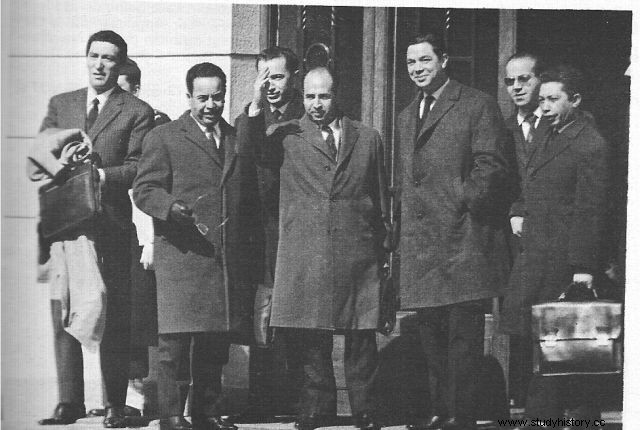- In 1954 the Algerian war began. But faced with a conflict that escalated, successive governments were unable to provide an adequate response to the decolonization movement that had been underway since the end of the Second World War. In 1958, de Gaulle returned to power, proposing some Algerian autonomy, but without endorsing independence.
- If the war can find a favorable military outcome for France, the political end does not seem viable. The Algerians are actively campaigning for their independence and the French population accepts this idea, as evidenced by the demonstrations, the carriers of suitcases with false papers, or the commitment of intellectuals (Manifeste des 121 ) like Sartre.
March 18, 1962

Characters
Charles de Gaulle
Maurice Audin
Maurice Challe
Procedure
The Evian Accords are signed between the French government and the Algerian National Liberation Front:they put an end to the war in Algeria. Several declarations make up the agreements:an inaugural declaration, which provides, following a referendum, for the constitution of an independent Algerian state; there are also two declarations, focused on the economic field, providing for economic cooperation between the two countries (France wishes in particular to have access to the riches of the Sahara's subsoil, and to be able to carry out its nuclear tests).
The texts also relate to the place of the French in Algeria:the agreements provide that they can remain on Algerian territory. In return, France undertakes to keep Algeria in the franc zone to facilitate exchanges between the two countries, offers technical assistance, and always wishes to provide educational and teaching staff, as well as administrative staff to facilitate transition.
Consequences
- The Évian Accords, the fruit of long negotiations and major compromises on both sides, led to a ceasefire the next day, March 19, 1962. The 1 st July 1962, Algerians vote 99.7% for independence.
- The Secret Army Organization (OAS) rejects the principle of a ceasefire and launches a wave of attacks in Algeria. A great wave of migration begins:the pieds-noirs (French from Algeria) and the harkis (non-independence Algerians) try to return to France.
- The war in Algeria was particularly violent and deadly:there were approximately 250,000 victims on the Algerian side, many of them civilians. The Maurice Audin affair, the demonstrations of October 1961 or February 1962 with the Charonne metro testify to the use of torture and repression by the French authorities. A memorial war between the two countries has remained strongly present since the end of the armed conflict, France and Algeria being in fact two countries linked by a common past.
